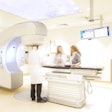The first major report from the American College of Radiology's (ACR) new Harvey L. Neiman Health Policy Institute (HPI) warns of diminished patient access to diagnostic imaging and other unintended negative consequences from public policies that have slowed imaging's growth.
In a Tuesday press conference announcing the report, Dr. Richard Duszak Jr., chief executive officer of HPI, criticized healthcare policymakers for pushing for reforms to lower diagnostic imaging use when utilization has actually declined.
"The question we all need to carefully consider is whether that is good in regard to overall healthcare costs and patient safety," he said.
The report -- titled "Medical Imaging: Is the Growth Boom Over?" -- found that rising medical utilization peaked in 2006 after eight years of double-digit percentage growth for Medicare Part B services. Since then, imaging volume in the U.S. has declined nearly 5% while spending on imaging is down 21% since 2006, he said.
Subsequent efforts to rein in costs have produced dramatically lower reimbursement, including nearly $6 billion in Medicare cuts for imaging services since 2006, Duszak said. The effects of these reductions vary by modality, but their cumulative effect for CT resulted in a 40% to 55% decrease in the rates paid for the technical component of imaging, and a 20% to 23% cut in professional rates paid to radiologists for reading the scans.
"[The idea that] imaging is a huge driver of healthcare costs is just a myth," Duszak said. "Our goal is to make sure ... that people are making policy decisions on real information rather than data that are 5 or 6 years old."
Duszak attributed imaging's growth from 1998 to 2005 to its "proven clinical utility," including its ability to provide rapid, accurate diagnoses; minimize the need for exploratory surgery; and allow physicians to rule out serious conditions.
The report also blamed financial conflicts of interest, such as in-office physician self-referral, and the fear of medical malpractice for driving growth.
As for the factors that slowed imaging utilization, the report singled out changes in the Medicare payment formulas in the Deficit Reduction Act of 2005, Medicare's adoption of multiple procedure payment reductions (MPPRs) for contiguous body parts and other procedural bundling strategies, and private-payor use of prior authorization programs contracted through radiology management programs.
Duszak credited ACR's Appropriateness Criteria, electronic physician order entry, Image Gently, and other programs aimed at reducing patient radiation exposure, along with increased use of electronic medical records, for cutting unwarranted use.
The steadily dropping utilization has raised concerns about access to imaging, with contributing factors including a decline in the freestanding imaging center market, slower adoption of new imaging applications, and less frequent technological innovation because of long equipment life cycles, with possibly poorer clinical outcomes, according to the report.
Duszak suggested that it may be more than a coincidence that the average length of hospital stay in the U.S. rose 6% over the same time period that medical imaging use fell. He noted this calculation was not part of HPI's original analysis, but he estimated that longer hospital stays could translate into up to $21 billion in added healthcare costs annually.
As evidence of imaging's positive effects, Duszak referred to a March 26, 2012, study in the New England Journal of Medicine by Dr. Harold Litt, PhD, and colleagues establishing the value of CT coronary angiography to rule out suspected acute coronary syndrome for many chest pain patients without the need for expensive hospitalization.
The report raised numerous questions about the relationship between imaging utilization and clinical outcomes, professional guidance and appropriate use, and the effect of reimbursement policies on research and development.
"I am personally concerned about whether these cuts will lead to a reduction in access to important screening services including mammography, colorectal cancer screening, and [dual-energy x-ray absorptiometry] for bone density," he said.
Named after longtime ACR CEO Dr. Harvey L. Neiman, HPI was founded in August 2012 to conduct research and assess public policy options concerning radiology's role in healthcare delivery.



















